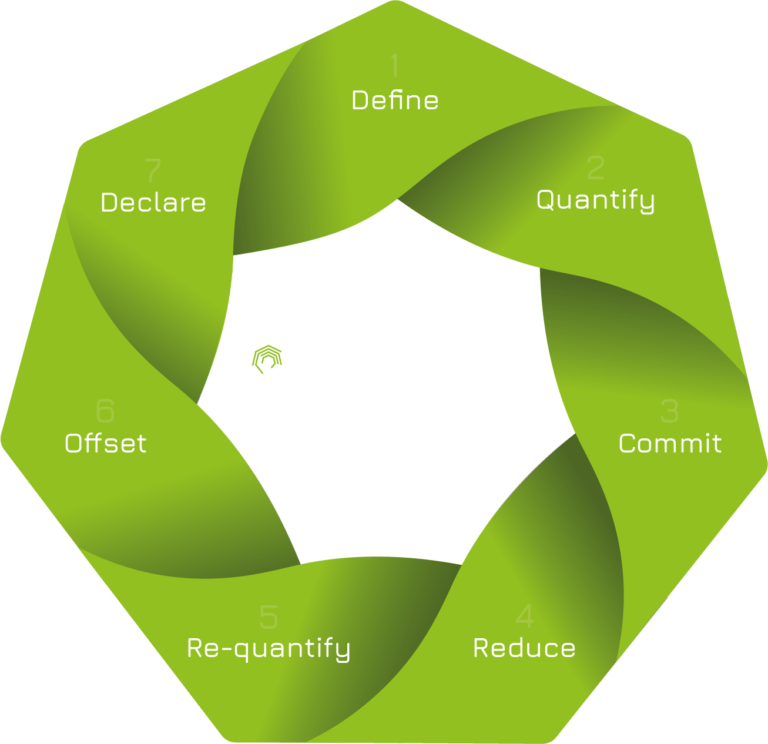As climate change continues to pose a significant threat to our planet, the importance of businesses actively reducing their carbon footprint and achieving carbon neutrality has never been more critical. To aid organisations on this essential journey, PAS 2060 has emerged as a global specification that guides both large and small companies alike towards operational carbon neutrality.
By following the comprehensive methodology presented in PAS 2060, businesses can make measurable progress towards mitigating climate change and achieving their sustainability objectives. This article aims to unravel the intricacies of PAS 2060, providing a step-by-step guide for organisations that are keen to embrace carbon neutrality and advance their commitments to environmental responsibility and sustainability.
This comprehensive guide examines the PAS 2060 process from start to finish, distilling each phase into digestible and actionable steps. We will delve into the requirements, methodologies and best practices for achieving carbon neutrality, offering a clear roadmap for organisations seeking to demonstrate their commitment to sustainability and environmental stewardship.
Step 1: Understanding the PAS 2060 Requirements
Before embarking on the journey towards carbon neutrality, it is crucial for organisations to understand the key requirements of PAS 2060. These include:
1. Quantification of Greenhouse Gas Emissions: Calculate the total greenhouse gas emissions associated with your organisation, product or service using the methodologies specified in ISO 14064-1 and the Greenhouse Gas (GHG) Protocol.
2. Implementation of a Carbon Management Plan: Create a comprehensive plan detailing your organisation’s commitment to achieving carbon neutrality, outlining reduction measures and setting clear time-bound targets.
3. Reduction of Greenhouse Gas Emissions: Implement reduction measures, track progress and demonstrate continuous improvement towards meeting your carbon reduction targets.
4. Offset Residual Emissions: Compensate for any residual emissions by investing in verified and certified carbon offset projects that adhere to internationally recognised standards.
5. Validation and Verification: Ensure the independence, accuracy and credibility of your carbon management plan, emissions calculations and offset projects through third-party validation and verification.
6. Public Declaration: Communicate your carbon neutrality status by issuing a public declaration supported by evidence of adherence to PAS 2060 requirements.
Step 2: Creating a Carbon Management Plan
A robust Carbon Management Plan (CMP) is an essential management tool for organisations seeking to achieve carbon neutrality. The CMP should detail your business’s commitment to carbon neutrality and outline the following key components:
1. Emissions Data: Include the baseline emissions data, scope and boundaries of your carbon neutrality claim.
2. Reduction Measures: Identify specific reduction measures, corresponding timelines, and associated emissions reduction targets.
3. Monitoring and Reporting: Establish a system for monitoring, measuring and reporting your progress toward carbon reduction targets.
4. Offset Strategy: Detail your approach to offsetting residual emissions, including the criteria for selecting offset projects and a plan to purchase the necessary offsets.
Step 3: Implementing Emissions Reduction Measures
With a detailed CMP in place, your organisation must take action to reduce its greenhouse gas emissions. This will involve implementing the identified reduction measures and monitoring the results. Some common reduction measures include:
1. Energy Efficiency: Improve energy efficiency through measures such as upgrading lighting systems, installing energy-saving appliances and enhancing building insulation.
2. Renewable Energy: Utilise renewable energy sources where possible, either through on-site installations or purchasing renewable energy certificates (RECs).
3. Waste Reduction and Recycling: Minimise waste and promote recycling initiatives within your organisation.
4. Transportation and Travel: Encourage the use of public transport, carpooling, or electric vehicles for business-related travel.
5. Employee Engagement: Foster a culture of sustainability and environmental stewardship among employees through training, workshops and recognition programs.
Step 4: Offsetting Residual Emissions
After implementing and monitoring reduction measures, businesses must offset any residual emissions that cannot be eliminated. To offset these emissions, your organisation should invest in credible carbon offset projects that adhere to recognised international standards, such as Verified Carbon Standard (VCS) or Gold Standard. Ensure that the projects align with your organisation’s values, operations and transparency requirements.
Step 5: Validation, Verification, and Communication
The final phase of the PAS 2060 process involves the validation and verification of your organisation’s carbon neutrality claim. Employ a third-party auditor to validate your calculation of emissions, reduction measures, and offset strategy. Following successful validation, obtain independent verification of your carbon neutrality claim before publicly declaring your organisation’s adherence to PAS 2060 and sharing your success story with clients, partners, and stakeholders.
Final Thoughts
Achieving carbon neutrality through PAS 2060 can be a powerful means for organisations to demonstrate their commitment to environmental responsibility and unveil a multitude of social, economic, and environmental benefits. By understanding the PAS 2060 requirements, creating a detailed Carbon Management Plan, implementing emissions reduction measures, offsetting residual emissions, and ensuring validation and verification, businesses can confidently advance on the path toward carbon neutrality.
This step-by-step guide from Carbonology has equipped you with the knowledge and tools necessary for success, positioning your organisation as a leader in sustainability and setting an admirable example for others to follow in mitigating climate change and preserving our environment for future generations. Schedule an appointment today to learn more about PAS 2060 certification.

